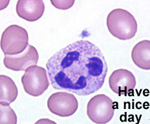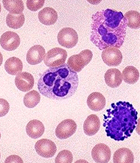| White blood cells
 Using the 10X objective, identify
white
blood cells (leukocytes) with lobulated nuclei, the granulocytes. Using the 10X objective, identify
white
blood cells (leukocytes) with lobulated nuclei, the granulocytes.
-
Note
their size compared to red blood cells.
- The most abundant granulocytes
are neutrophils.
Clinical note: A large
accumulation of neutrophils, especially dead and dying neutrophils
that have engulfed many bacteria, constitutes “pus.” Pus formation
is a normal part of an infection that occurs within connective
tissue or a tissue space.
Look for the other two types of
granulocytes:
- Eosinophils and
- Basophils, named for staining
properties of their cytoplasmic granules.
- These cells will be difficult to
find because respectively they represent only 2-4% and <1% of
the circulating leukocytes.
How do the functions of
eosinophils and basophils differ from each other and from
neutrophils?
Want to try for
a lymphocyte? |